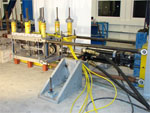
The new experimental facility of the
Structures Laboratory of the University of Patras focuses on testing engineering structures and comprises a strong floor, 18m by 16m in plan with 200kN-capacity anchor points spaced every 0.5m in both directions, and two strong walls. The walls are 1.0m thick, 5.5m high and 6m (the one) or 4m (the other) long and have an L-shape arrangement in plan, so that they can be used for bidirectional testing.

The system of the strong floor and the two reaction walls can be used for cyclic or pseudo-dynamic testing of earthquake-resistant components, subassemblies or small structures. To this end the Laboratory has a group of pumps with a capacity of 500lt/min, fulfilling the testing needs at every point of the lab through an oil distribution system (hard line).
A series of actuators is available: two large actuators (1000kN, 500mm stroke), and three static actuators of -640kN/+450kN with stroke capacity of 250mm (two pieces) and of -340kN/225kN, 125mm(on piece). In the near future three large dynamic actuators are to be added to the stock to be used for dynamic testing of components. Additionally, several jacks are available for the application of static loads, with capacities ranging from 300kN to 1000kN.

Testing is performed using a 2-channel MTS-Teststar II controller (suitable for cyclic and fatigue testing) and a versatile 4-channel custom-made controller (developed at the European Laboratory of Structural Assessment - ELSA, of the Joint Research Centre, European Commission and produced by MOOG, Italy) which facilitates cyclic, pseudodynamic and other testing schemes. The system is completed with a 64-channel data acquisition system and a series of various types of sensors (high resolution optical transducers, displacement sensors, accelerometers and inclinometers).
Structures Laboratory HomePage
Back